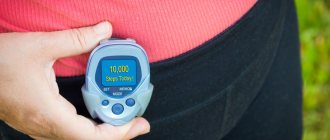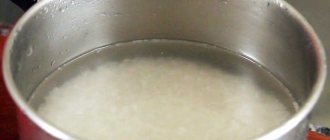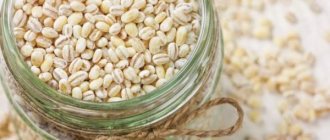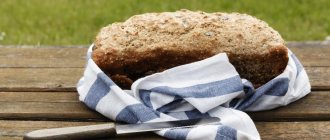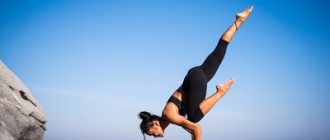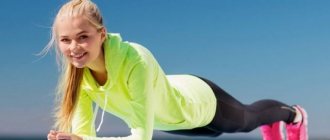Squats
18.06.2020 19:43
Author: Fitness trainer Sergey Konstantinov
Finding a simple, effective and universal exercise that will help improve the condition of the body and tidy up the figure is the dream of many supporters of a healthy lifestyle. In this case, you should pay attention to squats. This old and effective technique allows you to activate the functioning of body tissues, improve your mood and burn extra calories.
What's the benefit?
This type of gymnastics is rightfully considered simple and effective. Squats are part of a person’s daily natural actions, since this simple and effective movement is performed regularly: during breakfast, sitting down on a chair, at work, when you have to squat on an office chair and in many other situations.
When performing this habitual movement, many people are not fully aware of its benefits. Here are the main positive aspects associated with doing squats:
- Strengthening the leg muscles. During squats, the calf muscles, thigh muscles, and buttocks actively work. As a result of regular training, the athlete manages to pump up these areas and improve his appearance.
- Improved posture. When performing squats, the back muscles are strengthened, since in the process of doing them you have to activate this part of the body. As a result, the habit of keeping your back straight is formed, which has a positive effect on your posture.
- Increased muscle mass. If you squat with weights, you will be able to build muscle. The main thing is to first develop a training program and follow its points.
- Working out the muscles of the lower body. Squats allow you to actively use the muscles of the legs, lower back, and buttocks during training. After some time you will be able to admire the excellent results.
- Activate the activity of the cardiovascular system. This is a great cardio workout. Therefore, to strengthen the heart and blood vessels, it is recommended to include this complex in the daily exercise program. After 4 weeks of training, you can confidently note the positive effect of the exercises - your strength and endurance will increase.
- Increasing the body's resistance to various diseases. Starting squats is a great solution to improve your immune system. In addition, training improves mood and increases vitality.
- Working out coordination of movements. Exercises allow you to develop an excellent skill - strengthen coordination of movements. Regular training makes it possible to become accurate, which will certainly come in handy in everyday life.
Even schoolchildren know about the benefits of squats, since this gymnastics is part of the normative program. It is not forbidden to squat even in old age, since this exercise perfectly trains the heart muscle. Just before starting squats, it is important to warm up first. Without warming up, there is a high risk of injury.
Reduces the risk of sports injuries
If you are planning to sign up for a gym and regularly visit it, then you need to remember that the intense physical activity that your body will be subjected to there can negatively affect the condition of the joints and ligaments. Doing squats every day will help reduce the risk of sports injuries by making the muscles in your lower body more prepared to handle this kind of stress.
Squats are an excellent way to prevent sports injuries. By performing 100 or more squats daily, you strengthen your abs, ankles, knees, back and leg muscles, and improve the condition of your joints and ligaments.
Effect
If you squat regularly, you can get undeniable benefits for organs and tissues. This is due to the fact that during training a large number of muscles are involved, which begin to actively work. At the initial stages, preference should be given to the classic squat technique. And only after carefully working it out can you move on to more complicated gymnastics.
Here are the main positive effects:
- Toned and firm buttocks.
A beautiful thigh area is admired by both men and women. To give this part a toned and attractive look, you should include squats in your daily training program. After a month of training, you can observe an excellent result - an attractive appearance of the forms is ensured.
- Strengthening tendons, joints and ankles.
During squats, the lower part of the body actively works. In this regard, the active work of the limbs is noted, which has a positive effect on the development of muscles, joints and tendons.
In order not to overshadow the positive effect with unpleasant consequences in the form of dislocations, sprains and other problems, it is important to monitor the even distribution of the load on the body. You should not overload the body, trying to achieve optimal results in a short time. In squats, as in other types of gymnastics, it is important to maintain consistency and uniformity.
What happens if you do squats every day?
Working different muscle groups
Squats are very popular precisely because they work different muscle groups. The effect mainly affects the lower part of the body.
Different types of exercise work different muscle groups in different ways, but mainly work the quadriceps, calf muscles, buttocks, back, abs and hamstrings.
Weight loss
Daily squats are great for losing excess weight. They help speed up metabolism, so that fat begins to rapidly burn and turn into muscle.
Thanks to the work of the entire lower body, the buttocks are actively tightened and the stomach becomes flat.
Beautiful posture
When done correctly, squats strengthen your back muscles, which has a very beneficial effect on your posture.
The exercises work your upper back to help stabilize your core, whether you do the exercises with or without weights.
Prevention of sports injuries
In addition to muscles, squats help strengthen ligaments and connective tissue, which helps avoid many sports injuries, fractures and dislocations.
The flexibility and stability of the limbs increases significantly. The classic squat is the best way to strengthen muscles and ligaments. A uniform load when performing them increases body endurance and joint mobility.
Flexibility and coordination
Thanks to the even distribution of the load on the joints, daily exercise has a positive effect on their flexibility, strengthens them and relieves them from crunching during sharp turns and bends. At the same time, it is important to maintain a high range of motion of the hips while performing the exercises.
Harm
If we talk about the adverse effects that are possible when doing squats, then this type of exercise in itself is safe. Problems can occur if you squat incorrectly. And this is due to this:
- During squats, there is an active load on the joints, muscles and tendons. If you complicate the exercise in the early stages with insufficient preparation, there is a high risk of injury.
- You should not do squats if your doctor advises you to temporarily stop exercising. Unauthorized performance of gymnastics in the presence of contraindications in most cases leads to a deterioration in health and damage to the limbs.
These are the main points associated with the negative aspects that can occur when performing squats. To prevent anything bad from happening, you should be attentive to your health and respond to signals about even the most minor failures.
Improves flexibility and coordination
Doing squats every day improves flexibility. During the exercise, the load on the joints that actively work is distributed evenly. After some time after starting classes, you will forget about the crunch in your joints, and your body will become more flexible and pliable.
If earlier you had to bend over backwards to pick up a fallen object from the floor, now you won’t have any difficulties with this. Why? Because squats not only improve flexibility, but also have a positive effect on your coordination.
Contraindications
Squats are a harmless form of gymnastics. But even here it is important to follow safety rules and take precautions if necessary. Having decided to start training, you should first study the list of contraindications for which this type of gymnastics should be excluded from the training program.
Here are the main violations for which you should stop doing squats:
- Arthritis and arthrosis.
Inflammatory diseases of the knee, hip joints, and their injuries can provoke a relapse. To prevent this from happening, you need to stop squatting. If you really want to continue training, you should first consult a doctor.
- Spinal diseases.
Osteochondrosis and scoliosis are reasons to stop squatting. And this is due to an increase in the load on these parts of the musculoskeletal system. Especially you should not use a complicated version of squats or use weights. Such a complicated approach can provoke a worsening of the condition.
- Diseases of the cardiovascular system.
In case of myocardial dysfunction or hypertension, you should refrain from quickly changing body position. If you neglect this rule, you can provoke pressure surges and an attack.
- Excess body weight.
We are not talking about a few extra kilograms, but about dozens. And with such excess weight, it is better to refrain from squats. The fact is that when performing exercises there is an increased load on the joints, which can cause damage to them if the body weight is high.
Before you start squatting, it is important to get a general idea of the state of your body. If there are any disturbances or alarming symptoms that cause concern, you should contact a doctor who will professionally assess the situation and recommend the optimal solution. Also, you should not continue training if your health begins to noticeably deteriorate during the process of doing squats. In this case, you should stop exercising so as not to provoke relapses of various diseases.
Errors
Beginner athletes often make the same type of mistakes when performing squats. This circumstance significantly increases the load on certain areas of the body, which, if further performed at this pace and type, can provoke injury.
To make squats comfortable and effective, it is recommended to train in front of a mirror in the initial stages. This method allows you to evaluate the correctness of the elements and avoid negative consequences if the squat technique is violated.
Here are the main points to pay attention to when performing squats:
- Neglecting warm-up.
Before you start squatting, it is important to first stretch your body. Ignoring this part of the training can provoke dislocations, sprains and even fractures. Therefore, before the main part of the training, you can do rotations, turns, and running in place. If the workout takes place outside, you can jog 2 laps.
- Uncontrolled increase in load.
A common mistake made by beginners is to immediately take on gymnastics with complex elements and use weights. This approach will not bring any benefit, but will result in injury and deterioration of well-being.
- Hunched back.
You should squat with a straight back to avoid spinal injuries. Therefore, during exercise, you should carefully monitor the position of this part of the body during squats to prevent deterioration in well-being.
- Neglecting pain symptoms.
If squatting has become unbearably painful, then this reaction of the body should not be neglected. It is important to stop training until the condition of the body is fully clarified and, in the absence of contraindications, continue training.
In the initial stages of doing squats, it is important to carefully monitor the correct execution of the movements. After all the elements have been brought to automaticity, then it will be possible to remove the mirror and squat without contemplating yourself from the outside.
Technique
Before you start squats, it is important to first study the technique of doing them. The effectiveness of training and the absence of disruptions in the body during the implementation of gymnastic complexes depend on strict adherence to this nuance.
To immediately set a successful start, it is important to pay attention to the squatting technique:
- Starting position – feet shoulder-width apart, and feet slightly turned toes inward. At the very beginning of practicing the squat technique, you should dwell on this aspect in more detail in order to accurately work out each movement.
- The weight is transferred to the heels, and the knees are turned in the same direction as the toes. It is important to ensure that this aspect is followed to reduce the stress on the joints during squats.
- Keep your feet firmly on the floor throughout the entire squat cycle. This nuance should be taken into account so that increased stress on joints, tendons and muscles does not cause injury.
- It is also important to monitor the position of your hands during squats. They can be stretched out in front of you, placed behind your head or crossed over your chest.
- A slight deflection in the lumbar region allows you to evenly distribute the load. If you round it, then there is a high risk of increasing the load on this part of the body, which is dangerous due to breakdowns.
- It is important to keep your back straight and not tilt it. Straight posture is the key to successful gymnastics.
- Attention should also be paid to the correct position of the knees. They cannot be brought together or separated. It is important that they are turned in the same direction as the feet. They should be kept in this position throughout the entire exercise.
- The success of the workout depends on correct breathing. You should inhale as you go up, and exhale as you go down.
- When lowering during squats, it is important to monitor the depth of the lowering. It is advisable to lower until the floor is parallel to the thigh.
- During squats, it is important not to straighten your legs completely when lifting. They should be kept in a slightly bent position. This approach avoids joint injury.
These are the main points to keep in mind while performing squats. In the initial stages, you should be more careful and careful to avoid injuries and malfunctions of the body.
Squats are one of the most common exercises among fitness enthusiasts. It can be performed by both men and women, anytime and anywhere. The squat is often called the “king of exercises” because of its positive effects on the body. Today we will find out what happens if you do one hundred squats every day for three months. Try it, the result will not keep you waiting!
They say: “No squats, no glutes.” Indeed, this exercise should be performed by those who want to pump up their gluteal muscles. This will help correct the shape of the buttocks, tighten them and slow down the process of age-related loss of muscle tone. Sitting for long periods of time leads to weakening of the gluteal muscles, causing the buttocks to lose their shape and become flat. Doing squats regularly will help solve this problem.
Do you want to lose weight and speed up fat burning? Then do one hundred squats every day, as this helps increase energy expenditure, which leads to weight loss. In addition, squats use many muscles of the body, including the buttocks, legs, and abdomen, thereby gaining muscle mass. As a result, the process of burning fat starts, the basic metabolism accelerates, and you lose weight.
Squats allow you to get an aesthetically pleasing shape to your legs and stomach. It's no secret: to have a beautiful body, it is not enough to be thin; it is the muscles that give the body clear and toned outlines. By doing one hundred squats a day, your thigh muscles will become stronger and your thigh circumference will become smaller. This exercise will also help tighten your abdominal muscles and improve your core strength.
Nihon Keizai 12/31/2020 WeChat 10/23/2020 The Telegraph UK 04/07/2019
Squats are a good way to improve posture and correct curvature. Modern people sit for a long time, burying themselves in their phones, straining their necks and spine. After some time, many people develop stooping, crooked posture and other disorders that negatively affect their health and appearance. Performing squats allows you to stretch the muscles of your neck and back, relax your spine and improve your posture. Do this exercise regularly to keep your posture beautiful and straight.
Squats also normalize the functioning of the cardiovascular and respiratory systems. During the exercise, you must adhere to proper deep breathing. This helps oxygenate organs, improve blood circulation and maintain heart and lung health.
Many people worry that squats are hard on their knees, but in reality, squats without weights won't put much stress on your knees. Moreover, if the correct technique is followed, this exercise will have a beneficial effect on the health of the knee joints. When performing a squat, your back should be straight, your legs should be slightly wider than your shoulders, your knees should not extend beyond your toes, and your feet should be spread outward to 45 degrees. Slowly lower your body down to knee level, and then also slowly return to the starting position. Take your time while doing the exercise to avoid damaging your knees.
For those who have no experience in physical exercise, it is not recommended to immediately perform one hundred squats. It is better to start with ten repetitions a day and gradually increase the load to one hundred. If you do this exercise for a certain period of time, changes will occur in your body that will pleasantly surprise you and will have a positive effect on your health and appearance.
InoSMI materials contain assessments exclusively of foreign media and do not reflect the position of the InoSMI editorial staff.
Equipment
When starting to train, it is important to pay attention to purchasing accessories that will make training effective and safe. Here are the details to pay attention to:
- Weights.
In the initial stages of doing squats, they will not be required. But after mastering the classical technique, these accessories will be needed in order to pump up the muscles by increasing the load.
- Bandages.
Elastic bandages can be purchased at a pharmacy or sporting goods store. While performing squats, they should tighten the wrists and knee joints. This approach allows you to get rid of sprains and other injuries.
- Overalls.
This type of special equipment can also be purchased at sporting goods stores to help you maintain a straight back position when moving to a professional level of squats while using weights.
- Support.
Its role will be played by a bench or platform. It is necessary to perform the Bulgarian version of gymnastics, when, to complicate the task, one leg remains on the floor and the other on a raised platform. This approach allows you to more effectively pump the muscles of the thighs and buttocks.
These are the basic gymnastics accessories that are necessary for those who plan to train professionally. Amateur athletes will have plenty of weights and bandages.
Kinds
In addition to the classic method, there are other variations of this gymnastics. Experienced fitness trainers divide this training method into the following types:
- by location of the center of gravity;
- by depth;
- position of the feet;
- manner of execution - statically or dynamically.
Which squat option you prefer depends on personal motivation, physical fitness and preference.
With a barbell
This version of the exercise is classified as “based on the location of the center of gravity.” It is used more often than usual by weightlifters. It is not recommended to perform this element without prior preparation, as there is a high risk of injury.
To perform barbell squats, you must do the following:
- It is important to take the starting position with your feet shoulder-width apart with your toes turned slightly inward.
- After this, you need to take the barbell and place it on your forearms.
- Now you should perform squats, trying to maintain balance without shifting the center of gravity.
This type of gymnastics is suitable for experienced athletes who have worked their muscles and are ready for increased loads.
Develop coordination
In a squat, only the knee and hip joints are used. The rest of the body should be static. You can hold your hands at your head or in front of you. The back is straight and slightly tilted forward at the lowest point. The thighs in the squat are parallel to the floor, the feet do not come off.
To maintain this position constantly, rise and fall, you need to make additional efforts to maintain balance. Therefore, beginners are advised to do squats slowly to understand the technique, feel the muscles working and gain a sense of balance. Once your body gets used to the movements, you can speed up.
Swallow squat to improve coordination (Photo: www.pinterest.ru)
Swallow squats on one leg will also help improve your coordination. Take your other leg back and tilt your body forward.
Frontal
This type of squats is suitable for both experienced and beginner athletes. This gymnastics involves increasing the load through the use of weights. They can be used as small dumbbells, but there is another option. You can also use bottles with sand.
To perform this technique, a number of requirements and nuances must be met:
- It is necessary to take the starting position with your feet shoulder-width apart.
- After this, you should pick up weights and perform squats.
In this case, it is important to maintain the position of the hands along the line of the body. This type of gymnastics makes it possible not only to pump up the muscles of the legs, back and buttocks, but also to tighten up the arms. Due to the use of weights, there is an active effect on this part of the body.
How to do squats correctly?
Squats without loads
Squats may seem like a fairly simple exercise at first glance, but in order for them to have the maximum effect on the body, they need to be performed in the right way.
First, you need to choose the right exercise option that is suitable for your specific task and most effective for the muscle groups you want to train.
Squats on both legs use the thigh muscles to a greater extent, squats on the toes strengthen the calf muscles, and alternating squats on one leg are best for training the buttocks.
- The correct technique for classic squats for training the hips and lower legs: stand straight, keep your feet shoulder-width apart. We place our hands on the belt or spread them to the sides. Straighten your back. Bend your knees, resting on the entire surface of your feet. Hands can be pulled forward of the body or held at the back of the head. Return the body to its original position and repeat the squat.
- To develop the calf muscles, we perform the exercise according to the same scheme, but when performing the exercise we place emphasis not entirely on the surface of the foot, but only on the toes.
- To work on the inner thighs, do the following version of the exercise: put your feet shoulder-width apart, your knees should look outward. We spread our arms to the sides, or keep them on our belts. We perform the exercise by squatting as deeply as possible: how strong the effect will be depends on this.
When performing all types of exercises, it is important not to bend your back and keep it straight. Try not to lower your buttocks too low to avoid damaging your joints.
Remember that squats put a very large load on the spine, so they are strictly contraindicated if you have disorders in the functioning of the spine. In addition, it is not recommended to perform exercises if you have problems with your knees and joints.
Squats
When performing strength training in bodybuilding, one of the main exercises is squats with a barbell. The barbell greatly increases the load on the muscles, which allows you to achieve great results in pumping them up.
- When performing exercises, the position of your feet should correspond to the width of your shoulders, with your toes pointing forward or slightly spread to the sides. The barbell should be held with a closed grip, and your hands should be located at an equal distance from the center to avoid loss of balance.
- The gaze should be directed slightly above the horizon so that the neck is kept straight and does not fall down, in order to avoid the development of osteochondrosis and spinal injuries. Under no circumstances should your gaze be directed toward the floor when performing power squats.
- The barbell is best held on the shoulders to properly distribute the load, but some athletes prefer to place it on the shoulder blades or medial deltoid.
- Keep your back straight, slightly leaning forward. Movements should be smooth, knees should not protrude further than the feet. Unlike classic squats without a load, when performing exercises with a barbell, you can lower your buttocks to the floor - this will achieve greater efficiency.
Squats help strengthen the muscles of the body, make your posture beautiful, and help you lose excess weight. Remember that squats with additional load are not recommended to be performed every day. Be sure to take breaks to give your muscles a break from heavy loads.
Using the hack technique
This is a complex technique that requires the help of a personal trainer in the gym and good athletic training.
To perform this type of gymnastics, you must first place the barbell behind your back and raise your arms. During squats, you should raise and lower this apparatus. This results in an active load on the legs and arms.
But you should not master this area without prior preparation. Otherwise there is a high risk of injury.
Different muscle groups work
Squats are basic physical exercises that work several muscle groups at once. Did you think that this way you can only “pump up” your legs and buttocks? You are wrong! These are comprehensive workouts that are useful for strengthening the muscles of the entire body. By squatting, you force more than just the muscles of your buttocks and thighs to work. Let's not forget about the load that falls on the calves, lower back, abs, upper back and even neck. Try it yourself - to get into a standing position from a deep squat, the whole body “works”. Therefore, even if the goal of your visit to the gym is to get six-pack abs, don’t forget about the good old squats. Be sure to include them in your warm-up before your main workouts - simple and effective.
Exercise: Single Leg Squats
This type of squat will help level out the “imbalance” when one leg is weaker than the other. A common case. Stand up correctly - your back is straight, your arms are in front, your legs are shoulder-width apart. Bend one leg and take it back. Now start squatting. Lower your body down as far as possible. Then straighten up and repeat the exercise several more times, using the other leg. Try not to lower the leg that is bent onto a horizontal surface between approaches - this is the only way the maximum load will fall on the “necessary” muscles
.
Lesson program
Before you start squats, it's important to plan your workout ahead. Only with a competent and systematic approach is there a high probability of achieving certain successes in this direction. Therefore, in the initial stages, you should pay attention to the following actions:
- It is important to choose the optimal set of exercises. A great solution is to start with the classic version. You shouldn’t immediately pick up a barbell hoping for success. Sudden increased stress can provoke stress and relapses of chronic diseases. Only as the technique improves can you supplement the usual exercise with new elements.
- After choosing the appropriate exercise option, you should begin to perform it. First, it is important to develop a monthly training program. In this case, you should pay attention to the lesson schedule. In the first days, you should perform the element in 5 sets of 15 times. After 3 days of training, you should take a two-day break. The body needs time to regain its strength. After this, you should continue to study.
- After the two-week period, it is important to increase the number of gymnastics performed by one more approach. And so on until the total number of times in total does not equal 50.
- It is important to know that without preliminary warm-up you should not suddenly perform squats. This approach threatens to make you feel worse. In order not to harm yourself, it is important to first stretch your body and then load it.
- It is necessary to ensure correct breathing. You should not breathe erratically. If breathing becomes intermittent due to increased load, then you need to take a minute break and only then can you continue exercising.
Following these simple rules allows you to perfectly improve your health, raise your spirits, reduce excess weight and give a seductive look to your relief. But in pursuit of excellent results, you should follow safety rules so as not to harm your mental and physical health.
Read other articles:
- Inner thigh exercises
- Back exercises at home
- Endurance exercises
- Exercises with dumbbells
- Ball exercises
How to squat correctly to get rid of cellulite
Squats for cellulite will be most useful if you follow the execution technique and follow different training sets. The following types of exercises best fight orange peel:
- Traditional squats: straighten your back and place your feet shoulder-width apart. When squatting, you cannot lift your feet off the floor. Do 3 sets of 15 times. This exercise can be made more difficult by increasing the depth of the squats.
- Stand straight, feet shoulder-width apart, knees slightly bent. Taking a load (dumbbells weighing up to 5 kg or a barbell), stretch your arms forward or bring them to your shoulders. Perform shallow squats, 3 sets of 10 times.
- Spread your legs as wide as possible, put your hands on your waist and squat to a shallow depth (your hips should be parallel to the floor). Hold this position for several seconds. Do 3 sets of 12 times.
- Press your back against the wall and bend your knees until the position is similar to a “chair”. In a position where the kneecap is bent at an angle of 90°, hold for several seconds (from 60 s and above).
- Make lunges in different directions, while transferring your body weight to each leg and raising your arms up. Perform 2 sets of 10 times on each leg.
- Place your feet together, pull your stomach in and squat. When standing up, relax your abdominal muscles. Do 2 sets of 10 times.
- Train in a complex: squat - jump.
- Squat alternately, first on the left, then on the right leg.


